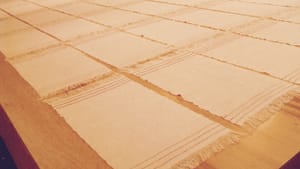Stay in the Loop
BSR publishes on a weekly schedule, with an email newsletter every Wednesday and Thursday morning. There’s no paywall, and subscribing is always free.
A forgotten flag
Fabric Workshop and Museum presents Sonya Clark’s ‘Monumental Cloth’

This is the flag that stopped the bleeding. A dishtowel pressed into service at Virginia’s Appomattox Court House signaled an end the Civil War. On the orders of General Robert E. Lee, a Confederate soldier waved the cloth, signifying surrender. It was April 9, 1865. The war was over.
Hostility, however, lived on—as proven by how few of us today know of the fringed white oblong with threads of red at either end, the Confederate Truce Flag. Everyone knows the Confederate Battle Flag, with its bold saltire and stars. In Monumental Cloth: The Flag We Should Know, textile artist Sonya Clark works in collaboration with the Fabric Workshop and Museum (FWM) to raise awareness of the truce flag and contemplate its significance.
Though it ended a war, the little banner could not bandage the wounds inflicted by a four-year conflict fueled by toxic hatred and deep cultural resentment that cost 600,000 lives. It never became recognized as a symbol of national reunification. The Confederate Truce Flag went to the Smithsonian National Museum of American History and was forgotten.
A racist talisman
Clark seeks to correct that. With five installations, a performance piece, and related events occurring throughout the exhibit’s run, Monumental Cloth invites consideration of the unresolved hurts that continue to divide races and regions, divisions made clear in the ongoing prominence of the Confederate Battle Flag, which remains a talisman of racist pride.
The humble Truce Flag has never been so embraced. Its simple design isn’t enshrined on memorabilia. Clark’s Propaganda (2019) confirms this. It’s a lengthy but incomplete list of commercially available products bearing the Confederate Battle Flag design. On a gallery wall, a list of items in red typeface runs three floor-to-ceiling columns. It includes almost everything necessary to outfit a home in which old times are not forgotten—including belt buckles, bottle openers, bedsheets, blankets, Christmas ornaments, cufflinks, cummerbunds, and scrunchies.
Hands on
Clark engages visitors with Lesson Plan (Confederate Truce Flag) (2019) and Reconstruction Exercise (2019), each of which invites them to create visceral memories of the Confederate Truce Flag. In Lesson Plan, they sit at old-fashioned wooden desks in a classroom formation. An imprint of the truce flag has been laser-cut into each desktop for visitors to make keepsake rubbings.
Beyond Lesson Plan sits Reconstruction Exercise: nine floor looms set up to weave replicas of the truce flag. Visitors can add to the design by sending the weft-carrying shuttle through the warp to add a few strands.

Iconic images and words
In Monumental (2019), Clark presents the flag in a size commensurate to its significance, enlarging it to 15 feet by 30 feet and mounting it on an angled platform to prevent stress on the fabric. This is precisely how the Smithsonian presents the Star-Spangled Banner, the flag that flew over Fort McHenry during the War of 1812. The sight inspired Francis Scott Key to write the poem that, set to a popular tune from the time, became the official US national anthem in 1931.
Had this magnified Confederate Truce Flag flown at Appomattox, would it be better known? Would the peace it initiated have been more genuine? The reconciliation more true? The colossal banner is silent on these questions but forces us to wonder.
In Many (2019), Clark makes her point using repetition. One hundred scale Truce Flags are laid out to form a single banner. Row upon row, separated by thin margins, individual pieces create one entity, automatically evoking the motto from the Great Seal of the United States: E Pluribus Unum (From many, one).
A grudging peace
The Confederate Battle Flag and the Confederate Truce Flag are opposites in every way. The ubiquitous battle flag, bold and garish, unfurled for national division, bloodshed, and the perpetuation of slavery. It was, and still is, a divisive symbol. The reverence in which the Confederate Battle Flag is held, and its ongoing visibility, are symptoms of festering societal ills. Conversely, the truce flag became a flag by accident, an unadorned scrap grabbed in desperation to end violence and summon opposing sides back to common ground. Its anonymity speaks to an incomplete, grudging peace.
By calling attention to the truce flag, Clark refocuses attention on the sentiments President Abraham Lincoln espoused in his second inaugural address: “Let us strive on to finish the work we are in, to bind up the nation’s wounds…to do all which may achieve and cherish a just and a lasting peace among ourselves.”
Perhaps, in our time, the simple white cloth can fulfill its unexpected destiny.
What, When, Where
Sonya Clark: Monumental Cloth, The Flag We Should Know. Through August 4, 2019, at the Fabric Workshop and Museum, 1214 Arch Street, Philadelphia. (215) 561-8888 or fabricworkshipandmuseum.org.
The Fabric Workshop and Museum’s main entrance is accessible for standard-size wheelchairs, and all floors are accessible by elevator and have wheelchair-accessible single-user restrooms. For specific questions about accessibility, call (215) 561-8888 ext. 233.
Sign up for our newsletter
All of the week's new articles, all in one place. Sign up for the free weekly BSR newsletters, and don't miss a conversation.
